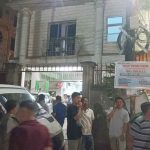By: Thoudam Jagat Singh, B.Tech (Hons), M.Tech (Dist)
Imphal valley is the birthplace of one of the earliest human civilizations in the north eastern region of India. The oval shaped Imphal valley covers an area of 1,843 sq. km approximately and situated 2567 feet high above the mean sea level. The area of Imphal Valley after the deduction of 600 sq. km of Loktak Lake is 1243 sq. km which is less than that of Delhi with an area of 1,484 sq. km. The valley is a natural gift of fertile agricultural land with the fertility being naturally renewed through flooding by the rivers. The valley with majority of urban centers is the focal point of population. The main issue of urbanization in Imphal valley is that it is taking place at the wrong area and is beset with many problems.
Imphal city is the major urban center where the populations as well as facilities are concentrated. With the increase in population due to natural growth as well as migration from rural areas, there is a great pressure on the infrastructure of Imphal city. Imphal city is now facing a myriad number of problems – traffic congestion, lack of parking space, flooding due to bad drainage, lack of water supply, lack of sewerage system, environmental degradation etc.. Possibility of the occurrence of flood every year is the biggest worry of a majority of people in Imphal city and other areas of the valley.
Another important aspect of the urbanization process is the loss of fertile agricultural land. The ongoing population growth and urbanization is fuelling the conversion of much of the best agricultural lands to non-farming uses. Once agricultural land is designated or developed for non-farming uses it is unlikely that it can be restored to produce agriculture. It can take thousands of years to produce just one centimeter of new topsoil needed to sustain food and farm production. Agricultural land is very scarce in Manipur. The valley constitutes just one-tenth of the total area. Development of agriculture and farming is essential for the growth of other sectors of the economy. Protection of agricultural land resources is necessary for the growth of a sustainable economic development, job creation, investment and growth.
All these issues are to be dealt in urban planning. Urban planning is a technical and political process concerned with the development and use of land, planning permission, protection and use of the environment, public welfare, and the design of the urban environment, including air, water, and the infrastructure passing into and out of urban areas, such as transportation, communications, and distribution networks. Regional planning deals with the efficient placement of land use activities, infrastructure, and settlement growth across a larger area of land than an individual city or town. Regional planning is a subfield of urban planning as it relates land use practices on a broader scale. Urban and regional planners develop land use plans and programs that help create communities, accommodate population growth, and revitalize physical facilities in towns, cities, villages, and metropolitan areas.
There is an urgent need to take up the urban planning from a new perspective. The new perspective is to take a holistic view of the Imphal valley as a whole with its surrounding foothills for urban and regional planning. From this perspective, the urban centers can be located on the foothills, where the fertility of the soil is low. The central valley can mostly be reserved for agricultural and allied activities. The location of growth centers on the foothills has the advantage of unlocking a vast untapped potential- irrigation, power, water supply, tourism, industrial growth centers etc.
It is really exciting to imagine the materialization of such an urban planning and development. For location of urban growth centers on the foothills, a roadway cum Tramway, aka 9Light Rail Transit) LRT link should run along the foothills connecting the whole valley and the existing urban centers. The Tramway, aka LRT is an efficient, aesthetic, durable and modern mass transport resource for medium-sized Indian cities. Multi community planned townships can be developed on the foothills along this link. Mini storage dams can be constructed at various locations on the foothills all along link. There are many natural water storage points on the foothills which can be used for irrigation, water supply, mini hydro power plants and tourism. Various industrial growth centers can also be located along this link.
The various advantages of such a planning can be – 1) developing a drainage plan for the Imphal city to solve the endemic flood problem, 2) providing the much needed irrigation to the agricultural land and hence increasing the agricultural and farmland productivity 3) increase in power production 4) increase in drinking water supply 5) growth in tourism, 6) saving/reclaiming of the agricultural lands and wetlands in the valley which is a necessary condition for progress and development of Manipur, 7) developing an organic relationship amongst hill and valley people through the development of multi community townships, 8) solving the traffic congestion in Imphal city. There can be disadvantages also as any development has a tradeoff. But advantages can outweigh the disadvantages. But thing is certain- this will solve the endemic flood problem of the Imphal valley.
It is hoped that the new government with a new perspective will look into this new perspective with all the earnest it has promised in the interest of the future of Manipur.












